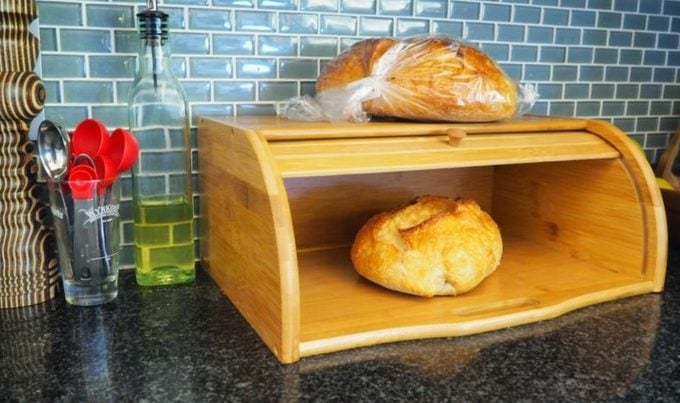Does a Breadbox Really Keep Bread Fresher?
Updated: Feb. 08, 2023
We tested the top-rated breadbox on Amazon to see if it kept bread fresher than storing it in a plastic bag. Did it work?

As a professional chef, I’m pretty obsessed with bread. I have a hard time knowing how to please those on low-carb or no-carb diets without it, and it’s a challenge to design gluten-free menus. Whether it’s a perfect brioche bun for a hamburger or a slice of sourdough bread alongside a bowl of pasta, bread always wins best supporting actor of my meal. But the challenge for any bread lover is knowing how to keep bread fresh.
I know breadboxes are making a comeback, and I wanted to see if it was for good reason. I decided to put this breadbox to the test!
What’s the experiment?
I picked up a few loaves of unsliced sourdough bread—all made at the same bakery—and stored them four different ways: in plastic wrap, in the plastic bag they came in, in a paper bag, and in the breadbox. I tried my best to forget about that moist crumb, crunchy exterior, and totally intoxicating aroma for a few days. (Okay, if I’m being honest, I bought a fifth loaf and devoured it on the drive back to my house.) I monitored the bread for the next three days before slicing it in half and assessing it for two more days.
A closer look at the results
The Method That Just Didn’t Work
The paper bag was, by far, the weakest link. By day two, it was hard as a rock. By day three, I could barely slice through its crusty exterior to cut it in half for the second half of the testing. While the inside was still nice and moist, I definitely would have had to use this stale bread hack to make it edible. So, when it comes to storing your bread, skip the paper bag. Look out for these 11 foods you’ve probably been storing wrong this whole time.
The Ones That Were Pretty Good
The plastic bag and plastic wrap methods were fairly on par with each other when it came to keeping the bread fresh. But, they both had a major disadvantage: the plastic suffocated the crust. By day three, the bread was still edible, but it was completely soft. It had lost that crispy exterior that gives bread its signature chew. They were both a little dry, too, although not completely stale.
The Winner!
The clear winner in this experiment was the breadbox. What makes the breadbox so much better for storing bread? It helped the bread retain its original characteristics: a crispy exterior, a moist crumb, and a delectable chew. Like a plastic bag, the box traps the moisture from the bread inside the container. But, unlike the bag, the box also is breathable, allowing some of that moisture to escape instead of softening the bread’s exterior. In short, the box creates the perfect humid environment to keep your bread at its peak for three or four days.
I will say, though, that the sliced loaf dried out on the cut end when stored in the breadbox. I was able to prevent drying if I pressed the slices together to protect the exposed slice, but the slices in the plastic could be fully exposed without drying out (at the expense of a crisp exterior, of course). Check out 32 more unique—and genius—kitchen gadgets.
How to keep bread fresh
If you’re buying pre-sliced bread, the breadbox might not be for you. But if you want to keep a store-bought artisan loaf (or, better yet, homemade bread) in its peak condition for a few days, I’d definitely recommend a breadbox. I picked up this model because it looks stylish on my kitchen counter and it’s flat on the top, giving me space to store other pantry items.
Using a breadbox is also a greener way to store your bread: no excess plastic needed. That means you’ll create less waste, both by going plastic-free and by preventing your bread from going stale. And, picking up a breadbox sounds like a good excuse to start making homemade bread!



















